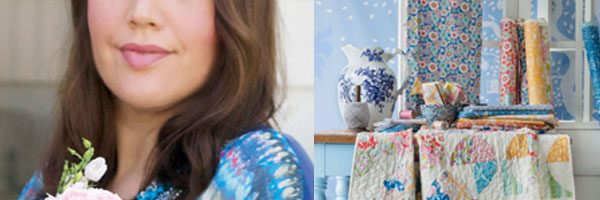
Selvedge with designer Lisa Mattock
Who needs therapists when you can take to stitching instead? That is, if you try the Lisa Mattock approach. Her explanation for her particular style of layer-upon-layer-upon-layer of patches, stitches and scrappy bits goes like this:
“Slow stitching, I call it. And it centres around ‘make do and mend’ and the ‘waste not, want note’ ethos of yesteryear. It encompasses the notion of slowing down mentally and enjoying the process of being mindful and involved in the project you’re creating. And using what you already have, in terms of fabric consumption.”
Yes, please, we’ll have some of that! Not only because it de-jangles rattly nerves, saves on psychologists’ bills and prevents waste, but because the finished pieces are absolutely exquisite. Oh, and it gets you out of the house in search of the soft treasure to be had at flea markets, charity stores and church fetes.
Simplicity is the key and satisfaction the reward, according to Lisa, who says that part of her approach is to give a generous nod to past generations who recycled out of necessity, not just to jump on a trend bandwagon. Those who struggled to make ends meet by using whatever they had available would have had no concept at the time of the admiration and inspiration they fostered with their inventiveness. They positive set a spark to Lisa’s flaming imagination, teaching her the value and beauty of time-worn discards and natural fibres.
“It’s their patina. Their stories. Their originality,” says Lisa. “I embrace the time-worn nature of my materials – cotton, linen, hemp …”
But flea markets and antecedents can only claim so much of the credit. The rest must go to the girl with the pearl of creativity – Lisa Mattock, who first saw the potential in the bygone beauties and then had the skill and imagination to turn them into crafting treasures. You can see what we mean in our photos here. Her work is a lesson in how to layer scrappy fabrics and then embellish them with stitching until you achieve a wondrous tactility and wonderful aesthetics.
“I create the ‘patched’ background using simple stab stitch to connect the pieces of upcycled cloth,” she says. “The joy is in the slowness of the stitching process – no whizzing along with a sewing machine! I will perhaps add areas of boro stitch or cross stitches to the panel after the background pieces are all together, to give texture. A simple, naive, stitched silhouette, perhaps with an element of raw-edge appliqué is then added as a finishing embellishment.”
Make a framed embroidered wall hanging with designer Caroline Sharkey
And what does she end up with? Boughs and birdhouses, embroidered and appliquéd buds and blooms, hanging hearts on lines, and bite-size pears all growing in fabric gardens of florals, linen swatches, lengths of lace and cheesecloth swabs, held secure with lovely lumpy stitches. It’s all just glorious.
And to plop a cherry on top on this craft idyll, Lisa admits to having a dream home studio (“It’s my haven … full to the brim with all my found treasures.”) and total satisfaction from her work (“Yes! Yippee!! Lucky me!”).
“It’s my ‘happy place’, where I most feel like myself. And being able to share that with my students is such a gift. Someone very wise once said, ‘Find something you love to do, share it with abundance and you’ll never feel like you’re working a day in your life.’ Mission accomplished!”
Lisa Mattock’s business is called ‘Forage’. To find out more about her work and workshops, go to www.foragebylisamattock.com.au and www.instagram.com/foragebylisamattock.






